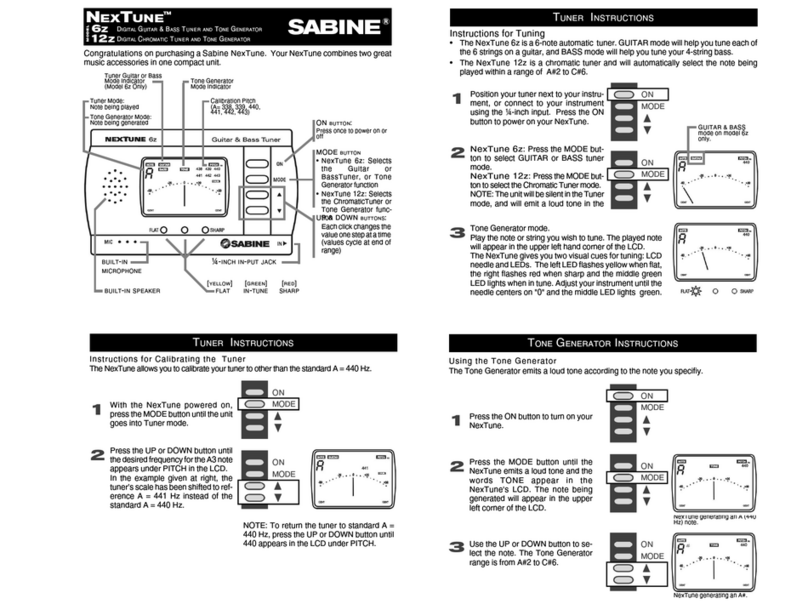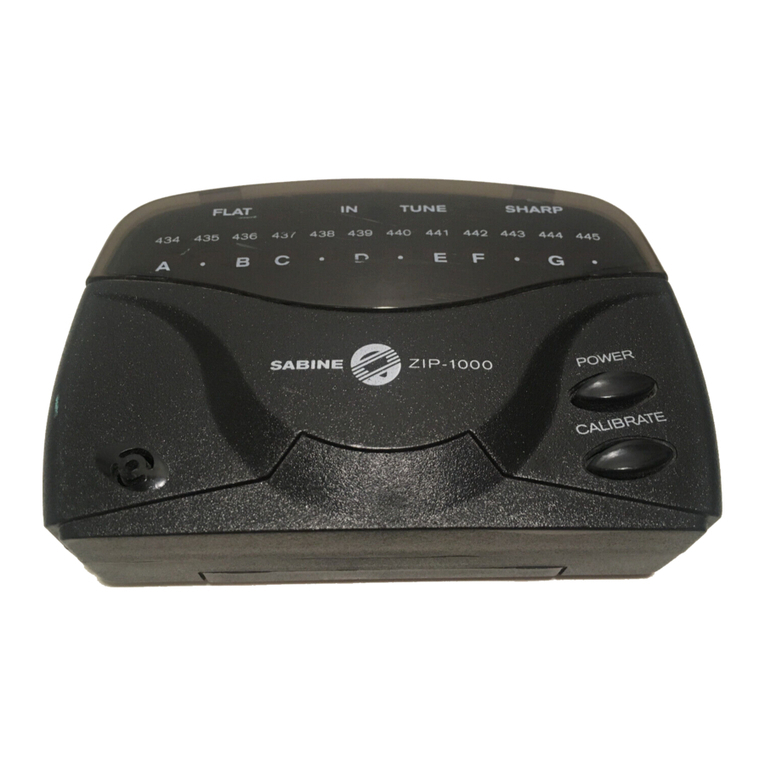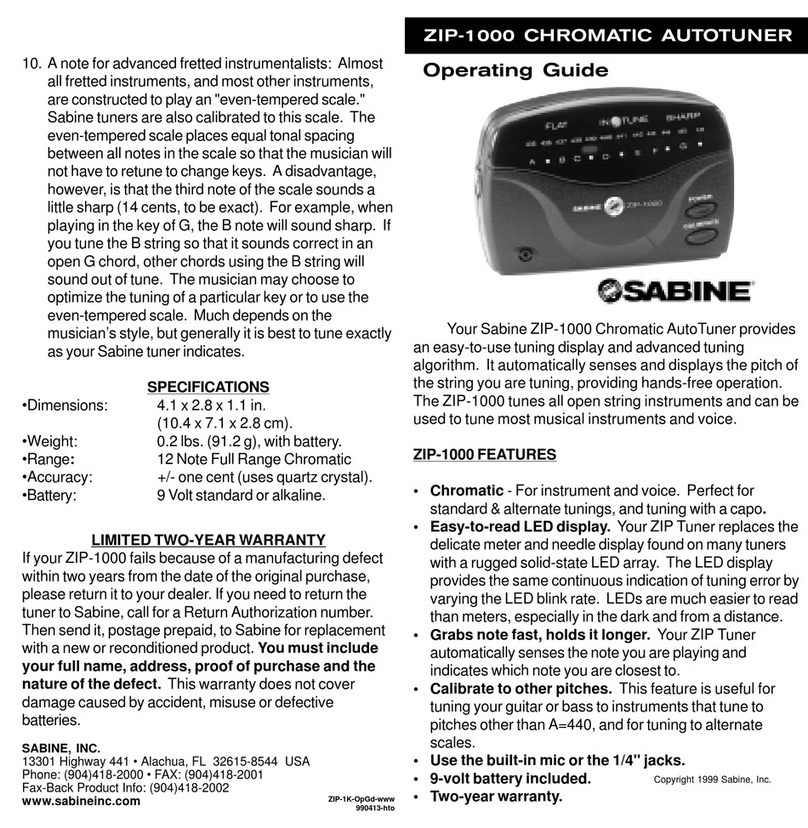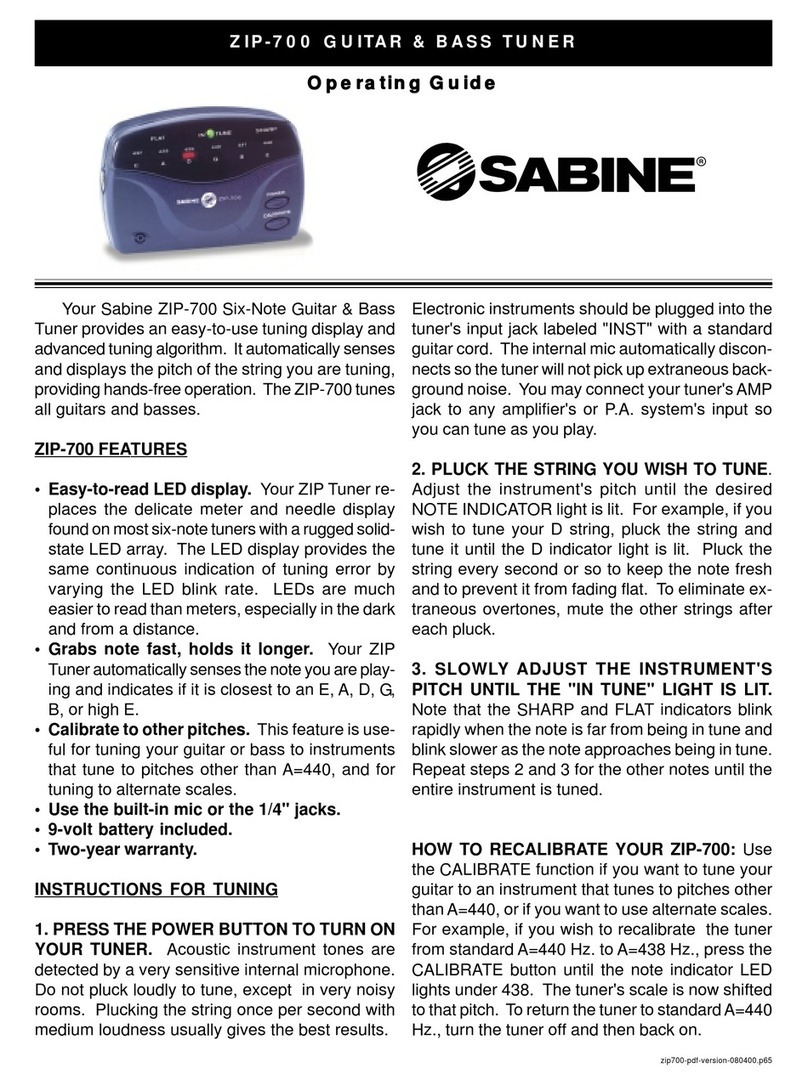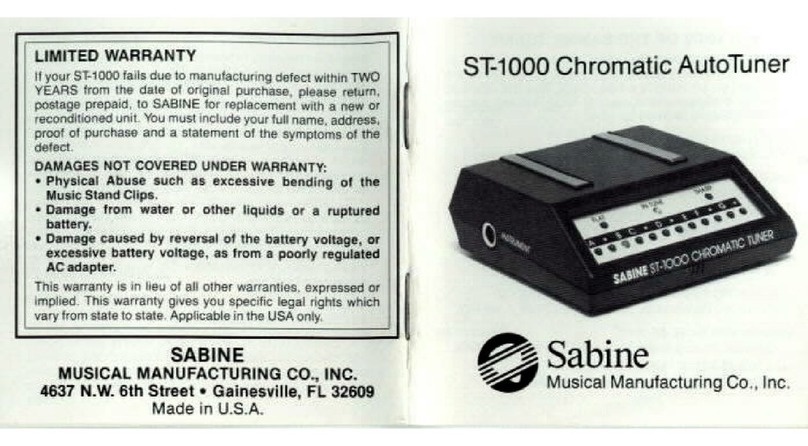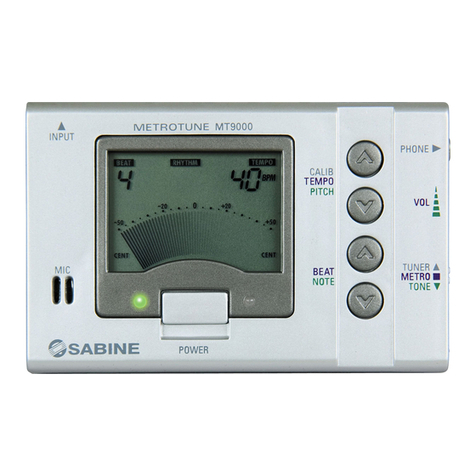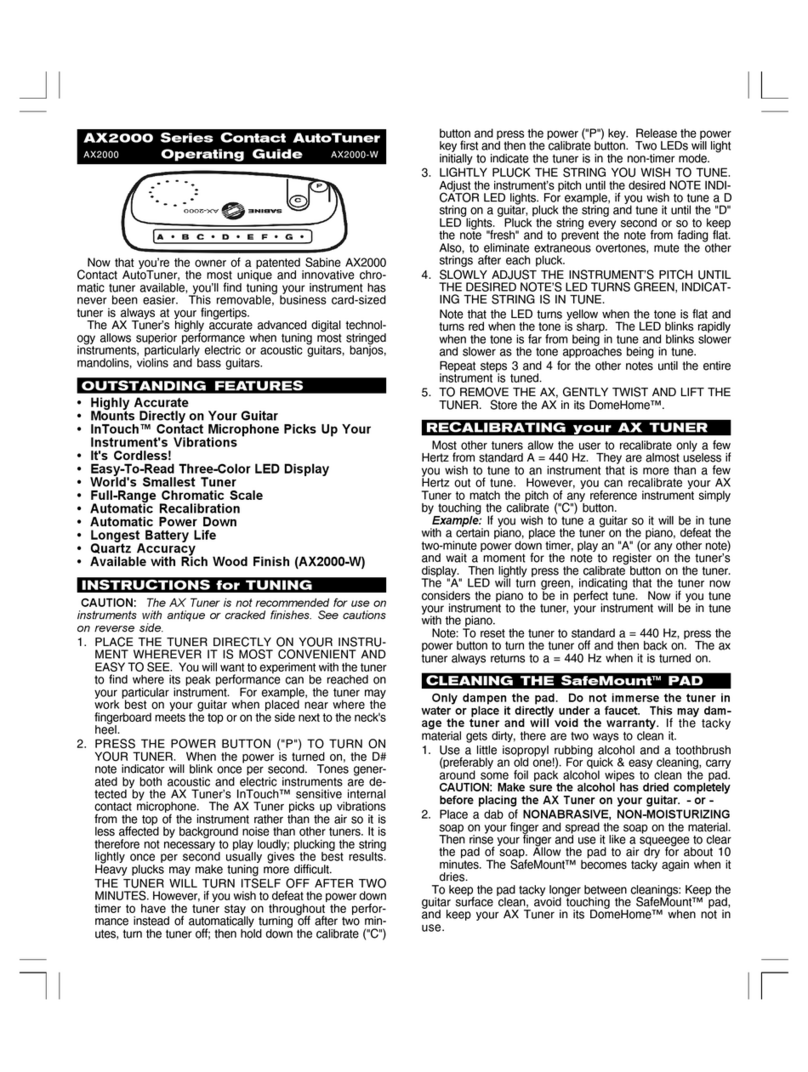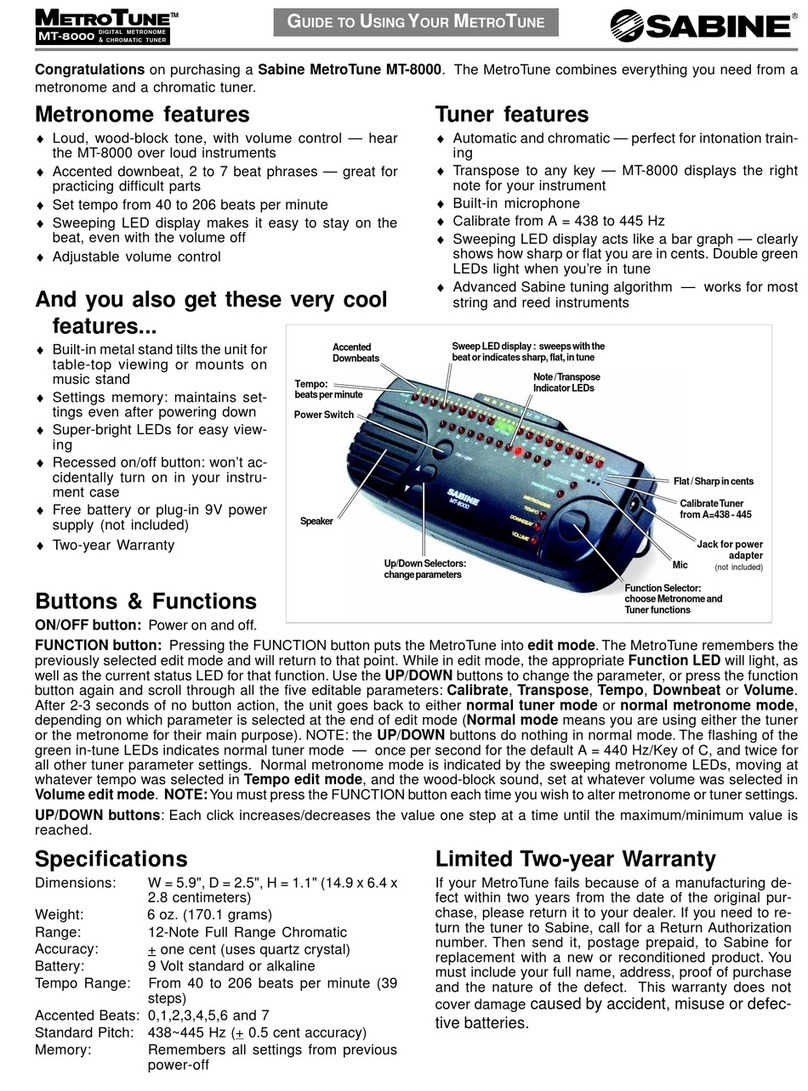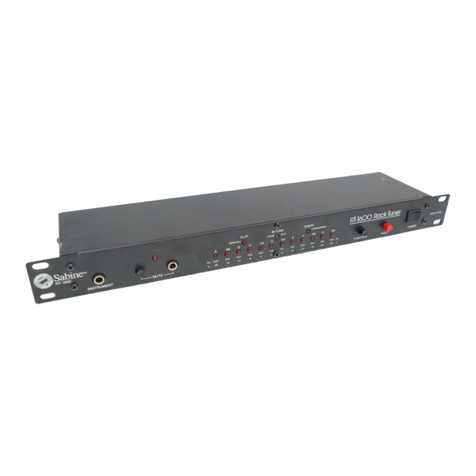
HOHO
HOHO
HOW TW T
W TW T
W TO RO R
O RO R
O REE
EE
ECALICALI
CALICALI
CALIBB
BB
BRR
RR
RAA
AA
ATE YTE Y
TE YTE Y
TE YOO
OO
OUU
UU
UR PR P
R PR P
R PII
II
IK-7K-7
K-7K-7
K-700 TU00 TU
00 TU00 TU
00 TUNN
NN
NEE
EE
ERR
RR
R
Most tuners on the market allow the user to recalibrate only a few Hertz from standard A=440 Hz. They are
almost useless if you wish to tune to an instrument that is more than a few Hertz out of tune. However, you can
recalibrate your PIK-700 Tuner to match the pitch of any reference instrument by simply touching the RECAL
selector.
Example: If you wish to tune a guitar so that it will be in tune with a certain piano, simply play an “A” on the piano,
and wait a moment for the note to register on the tuner’s display. Then touch the RECAL selector on the tuner.
Instantly, the IN-TUNE light will turn on, indicating that the tuner now considers the piano to be in perfect tune.
Now, if you tune your instrument to the tuner, your instrument will be in tune with the piano. To return the PIK-
700 to standard A=440 Hz, simply turn the power off and then back on.
HOW TO TRANSPOSE
Unlike most other six-note tuners available, you can transpose your PIK tuner one half-slop sharp or fiat. For
example, to transpose your tuner one half-step flat, simply follow theAutomatic Recalibration procedure above,
but play an ‘A-flat” on your reference instrument. To transpose one half-tone sharp, play an “A-sharp.”
PP
PP
PII
II
IK-7K-7
K-7K-7
K-700 SP00 SP
00 SP00 SP
00 SPEE
EE
ECC
CC
CII
II
IFF
FF
FII
II
ICACA
CACA
CA
TITI
TITI
TIOO
OO
ONN
NN
NSS
SS
S
· Dimensions: 4.6 in. X 4.1 in. X 1.32 in. (11.7 cm. X 10.4 cm. X 3.35 cm.)
·Weight:.25pounds(114 gm.)
· Notes tuned: E,A, D, G, B, E
·Range:Tunes the open strings ofguitars,banjos, mandolins, violins,and4-and 5-string basses·
·Accuracy +/- 1 cent
·Battery: 9 Volt standardor alkaline
·Options: ContactMicrophone
CM-1 Contact Microphone (Optional) The Sabine CM-1 contact micro-
phone makes tuning an acoustic instrument as easy as tuning an electric
guitar. Its removable rubber suction cup sticks the mic directly onto the
instrument. The CM-1 is ideal for tuning an acoustic instrument in a noisy
room or for tuning instruments that have very short tones like banjos and
mandolins.Askyourdealer aboutSabine’sContactMicrophone today.
Sabine CM-1 contact microphone
Mostmusical instruments havepeculiarities that causeannoying tun-
ingproblems.Fortunately, most of thesepeculiaritiesare over-come
byfollowing these simpleprocedures:
- Pluckonestring at a time.
- Plucktheinstrument oncepersecondtokeep thenote“fresh”while
youaretuning. Notesgonoticeablyflata secondor twoafterbeing
plucked. Iftuning a higher-pitched instrument (suchasa mando-
lin),plucka little faster; for a lower-pitched instrument(suchasa
bass),pluck slower.
- Do not pluck loudly. Generally light to medium volumes provide
purertones that areeasierfor tuners toanalyze.
- Pluck the strings with the flesh of the thumb. Fingernails and flat
picksadd overtones and slowthetuning process.
- Tunefromapitch thatis flat upto the pitchyou desire. This proce-
dure removes any slack in the gears of the instrument’s tuning
heads. Ifyoutune from sharp to intune,the gears will slip asyou
play, and theinstrumentwill go flat aftera few minutes ofplaying.
- If you have difficulty getting a note to register on the tuner, touch
theother strings lightlytostop their sympatheticvibrations.
- Use good strings. Old strings lose their uniformity and do not vi-
brateevenly.Remembertostretchyournewstringsout;newstrings
stretchflat as you play.
- Allsourcesoffriction cause tuning problems. For example, if the
slot in an instrument’s nut is too tight, the string will be pulled flat
as it is played. A tight nut (or capo) will cause the string’s pitch to
changein stepsratherthan evenly.
- Avoid pressure on the instrument while tuning. Even moderate
pressureon the neck ofaguitar will causeanoticeable change in
pitch. Also, press the strings straight down to the fingerboard.
Bendingthe strings sideways is verycommon,especially on diffi-
cultchords,butcauses the strings to be pulled sharp.
- Anoteforadvancedfretted instrumentalists.Almostallfretted in-
struments,and mostotherinstruments, areconstructedto playan
“Even-TemperedScale.”Sabine tuners are alsocalibratedto this
scale.The“Even-Tempered Scale”placesequal tonalspacing be-
tween all notes in the scale so that the musician will not have to
retunetochange keys.Adisadvantage, however, is that the third
note of the scale sounds a little flat (14 cents, to be exact). For
example,whenplaying in the key ofG, the B will soundflat.If you
tune the B string so that it sounds correct in an open G chord,
other chords using the B string will sound out of tune. The musi-
cianmay chooseto optimizethetuningofa particularkey ortouse
the“Even-TemperedScale.”Much dependsonthemusician’sstyle,
but generally, it is best to tune exactly as your Sabine tuner indi-
cates.
SOME STRINGED INSTRUMENT TUNING TIPS

